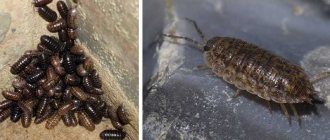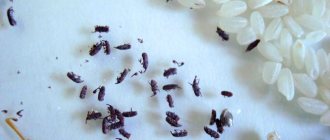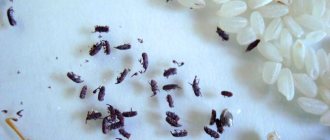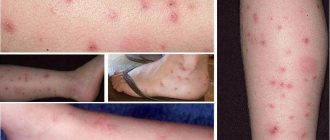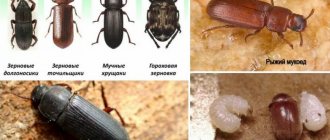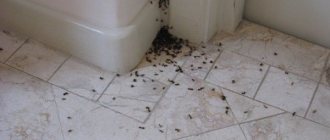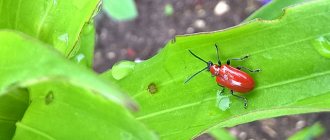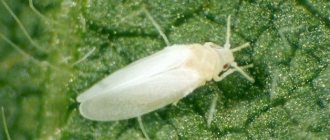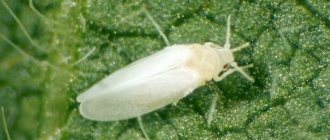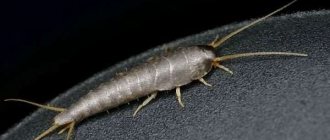Plants » Flowers
0
1801
Article rating
Kira Stoletova
Small white bugs appearing on an orchid are a common problem that almost all flower lovers face. Infection with mealybugs (often called hairy lice) without the necessary treatment leads to a gradual deterioration in growth and wilting of the plant, so it is worth starting to fight them much earlier.
Fighting white bugs on an orchid
What insects can appear in the soil?
A wide variety of insects can live in the substrate: wood lice, millipedes, spiders, ants, cockroaches, snails. The ones listed below manifest themselves most often.
Thrips
Thrips are small black creatures, sneaky and fast, almost elusive . As they move, they leave a trail behind them - silvery paths and many black dots on the leaves.
Fools
They are typical inhabitants of moist substrates. Most often, their presence is extensive in orchids that grow in moss. They are also extremely fast and nimble.
Podurs cause very significant damage to the plant, sucking out vital juices, as well as gnawing young and fresh shoots, not allowing the plant to develop and grow normally. They deteriorate the overall health of the flower.
Why are white bugs on an orchid dangerous?
What to do if there are white bugs in the orchid?
These insects have an oval body shape, and are completely painted with a white fluffy coating. The color is white, sometimes pink, with transverse stripes, which makes them stand out against the background of the flower.
With the help of colors, these bugs can be seen, despite their rather small size, from 3 to 7 mm. These insects produce white, sticky mucus that resembles cotton balls.
Under this covering you can find these small white pests or their clutches of eggs.
The mucus of these insects prevents orchids from carrying out gas exchange. Insects are usually located on young shoots, in the axils of leaves or inside them while they have not yet opened, as well as in buds.
To date, about 1,600 species of mealybugs are known. They have one characteristic feature. Namely, each such insect has a wavy fringe along the body, often stained with that white cotton-like mucus under which they prefer to hide. They rarely leave the place they like.
To feed, these bugs need plant sap, which is how they cause harm. In addition, mealybugs secrete nectar, which promotes the spread of mold fungi and attracts other pests to the indoor plant. If measures are not taken in time, the flower will die.
In behavior, these white bugs resemble aphids: they consume plant sap, filling the resulting void with harmful substances.
This impairs plant growth and promotes leaf loss. Infected orchid leaves become marbled in color. If there are a lot of mealybugs on an orchid, this will deform the flower.
Consequences for the plant of the presence of such pests
A large number of pests affect almost everything: they suck the juice out of the plant, and lay larvae in the root system, which in turn grow and use young roots and shoots of leaves as food.
Among other things, insects also affect the appearance by destroying foliage. Therefore, it is very important to know where small midges and other bugs in the soil come from and how to get rid of them.
Picture of the disease
At first glance, this pest looks like a small piece of cotton wool, but under the white bristles, which are threads of wax, hides an oval-shaped insect about 0.4-0.5 centimeters in size. This is a female mealybug.
The insect feeds on the juices of the plant and, as a result, deprives it of useful substances necessary for normal development. An additional problem is created by a sweet secretion (honeydew), which is intensively secreted by females. This sticky liquid, remaining on the leaves and stem of the orchid, can cause the development of fungus or attract other pests. A particularly large volume of honeydew is produced by female citrus mealybugs, which are most often found on orchids.
Symptoms of an orchid being affected by a mealybug:
- small white furry bugs are localized on the leaves, peduncles, buds, and core of the orchid;
- sticky spots or drops on the surface of the leaves;
- white powder-like coating;
- yellowing (or redness) and falling of leaves;
- slowing or stopping growth;
- deformation of buds and flowers.
Attention!
An unpleasant feature of most species of these pests is the ability of females to reproduce without fertilization by males. Moreover, each individual can lay 200-400 eggs.
See also: “Caring for an orchid in a pot at home.”
Why might they appear in the ground?
To a large extent, pests reach the plant through the soil. After all, one way or another, the soil contains quite a lot of different organisms that initially live there because of the comfortable environment for reproduction and existence.
Therefore, when purchasing soil for a plant, you must be prepared for the fact that you will have to deal with pests located there. Moisture also actively helps bugs and midges to reproduce, so you should not overwater the plant, because this can only provoke pests even more.
Possible places and causes of parasites
On the entire surface of the plant. At any stage of development, the insect is very mobile and moves well in any direction.
Interesting! A healthy orchid secretes pheramones that repel pests. Weakened specimens are attacked.
The most favorite habitats are leaf axils and buds.
Young shoots with a fragile skin are easily damaged and are most suitable for obtaining juice. Mealybugs willingly colonize secluded areas at first. Some types of white beetles parasitize in the soil, damaging aerial roots.
What should you avoid in insect control?
If you notice that the condition of your plant has worsened, then do not panic and take on all methods at once. Clearly identify the problem based on symptoms and approach treatment wisely . Timely intervention will definitely help save the life of your flower. You should not overuse various types of chemicals, because an orchid is a delicate flower.
There is no need to experiment with different methods of struggle; if one specific remedy is chosen, then it should be used to the end.
White sticky coating on leaves and stem
If a white sticky coating, similar to a cobweb, has formed on the leaves or stem, this is a sure sign of the presence of a mealybug. The pest lays its eggs under it. An adult female of white, beige or pink color reaches a length of no more than 5 mm, and the bristles along the body are covered with a white powdery coating.
A white coating on an orchid indicates the appearance of a mealybug.
The defeat of an orchid by a mealybug occurs in several stages:
- The appearance of sticky drops on the leaf blade;
- Formation of a white sticky coating similar to cotton wool;
- The shape of leaves and buds changes, the leaf blade becomes marbled in color with yellow or red spots.
In the later stages of the disease, the process of photosynthesis in the leaves is disrupted, which leads to the death of the orchid.
What to do if pests are found in the soil?
Insecticide.- Laundry soap for soap solutions (insecticidal safe).
- If the damage was very strong, add spraying to the alcohol and soap treatment with a special solution - chemicals purchased at a flower shop for pest control, for example: Aktara, Aktellik, Fozalon, Fitoverm.
- Agravertine is a weak-acting drug (5 ml per 1 liter of water, often requires re-treatment).
- BI 58 is a strong preparation with universal action (30 ml per liter of water, a single treatment is enough).
Fighting methods
At the early stage of infection, it is not difficult to cope with the pest; it is enough to use folk or mechanical means available at any time, even to a novice gardener.
Severely damaged orchids can only be saved by chemical treatment; a dying plant simply does not have the time or energy for the rest.
Mechanical
In this way, single insects are removed from the orchid. It involves removing insects and their eggs manually.
At the very beginning of infection, there is still a chance to clean the entire plant with a cotton swab dipped in alcohol or soapy water.
Be sure to remove and destroy the most heavily infected parts of the plant. The leaves are cut in half along their entire length, then removed from the growing point.
To destroy a male, unlike a female that can fly, it is enough to attach adhesive tape next to the affected plant.
Carry out a thorough wet cleaning of the area where the pot with the infected orchid is located.
People's
The method is suitable, but not at the last stage of infection. Spraying is carried out with home-prepared solutions every 3-4 days.
Effective infusions:
- from cyclamen tubers (pieces of tubers are boiled and kept for 24 hours);
- from chopped garlic (a head of garlic per 0.5 liters of water);
- from tobacco crumbs (100g of tobacco pour 1 liter of boiling water, leave for at least 5 hours).
A thick soap solution (tar soap) also has a detrimental effect on the pest.
All this is accessible even to a novice gardener, but you should not hope to destroy parasites in one spraying.
Attention! It is convenient to apply the prepared solutions to damaged areas with a soft brush.
It may be necessary to carry out several or complex treatments.
Chemical
Spraying with systemic insecticides has a positive effect, but they try to use them only as a last resort. If the situation with a pest has reached a critical limit, there is no question about the rationality of using chemical protection agents. It is urgent to save the tropical beauty.
The difficulty lies in the fact that white bugs of different ages and at different stages of development can be present on an orchid at the same time. In this regard, processing is carried out in several stages.
To completely destroy the population, it is necessary to get rid of each wave of hatched scale insects. You will need at least 3–4 treatments every 3 weeks.
Oil preparations are applied to areas affected by white bugs (oil impedes the process of photosynthesis).
After treatment, plants should absolutely not be placed in direct sunlight. There is a possibility of burning the treated areas.
The use of chemical control agents is carried out in compliance with safety rules and strictly according to the instructions.
Step-by-step instructions on how to fight
With midges
The pest control process involves:
- If insects are found, immediately treat the orchid and the substrate, first rinse under running water, then, based on the species that has colonized the area, disinfect it if necessary.
- It is also necessary to spray the substrate and the lower part of the plant with phytoverm according to the instructions twice with an interval of 7-10 days.
- Repeat the procedure twice after 7-8 days to be sure of the precise destruction of small midges and a favorable soil structure for the plant.
With white bugs
- Garlic solution helps very well in pest control. To do this, chop two heads of garlic and add a liter of water, place in a cool, dark place to infuse for about 5-7 days. Afterwards, strain the resulting infusion by half with water and spray the plant.
- To get rid of voracious bugs that harm the plant, changing the climate to one unfavorable for them usually helps.
- In greenhouses, humidity is reduced, because it is moist soil that is extremely favorite for all pests to reproduce.
If this is not enough, then more effective methods are used using mechanical traps.- Most often, the most effective method is to use bait.
You should put bait (a piece of cucumber, for example) on the surface of the substrate and then watch for a certain period of time, waiting to see if someone will come to eat it. Some people put a regular saucer filled with beer (beer trap), preferably a dark one. The aroma attracts some species of inhabitants, allowing them to be caught. This procedure allows you to manually catch large pests such as snails or spiders. It is worth repeating the harvest until the harmful guests completely disappear, and also periodically check their presence in this way.
The main thing is not to forget about the bait, not to leave it for too long, so that it does not mold or rot, causing other diseases of the delicate flower to occur.
How to get rid of parasites?
If there is any suspicion of the presence of insects on phalaenopsis or in the substrate, the following steps must be taken:
- The orchid is placed away from other flowers, moving it to another room.
- Flowers that were near the infected phalaenopsis are quarantined for several days. At this time, you should carefully monitor their condition.
- The orchid is carefully inspected and any pests found are removed. Damaged areas of greenery are cut off, sprinkling the sections with crushed coal or antiseptic.
- The flower pot is immersed in water for a few minutes. This way you can get rid of insects that float to the surface of the water.
- The plant is thoroughly wiped with a sponge generously soaked in soapy water. For varieties with dense leaves, you can use alcohol, but be careful not to burn the greens during the procedure.
- Change the top layer or the entire substrate. Sometimes you need to change the pot too.
Reference! If pests were detected at the first stage of settlement, then these procedures will be sufficient.
Methods of control and treatment
If a massive colony of pests with larvae is detected, the above procedures will not help. In such a situation, more drastic methods of controlling parasites will be required. These include:
- chemical treatment;
- treatment with folk remedies;
- use of biological drugs.
Prevention
To avoid new infections of the soil cover by various pests and maintain the health of the entire plant, you should monitor the condition of the plant. It is necessary to carry out preventive actions :
- Standing near plants with a solution of Itoverm or Actellik.
- It is extremely important to keep the inside and outside clean, so it is necessary to wash the substrate and wipe the leaves to prevent the bugs from finding a favorable place to live.
- The place where the orchid stands must always be kept clean, then the plant will never be infected with podura or other insects that are harmful to home flowers.
If you become the happy owner of an orchid, do not forget that your new family member may also get sick, which will negatively affect both the other inhabitants and you, because you will not get the same amount of aesthetics that you were hoping for if your flower is exposed to pests, therefore, be attentive and caring so that the color of your plant pleases you for as long as possible .
We recommend that you look at our other materials on what to do and how to get rid of orchid pests such as mealybugs, scale insects, mites, including spider mites.
Why do parasites appear?
If the orchid is completely healthy, it independently protects itself from pests. Due to the fact that it can produce special substances that do not allow insects to settle on the plant.
The appearance of scale insects indicates a weakening of the orchid. It occurs as a result of metabolic disorders, due to deterioration of living conditions or errors in care. Most often, infection occurs in winter, when the ambient temperature, lighting, and humidity change.
It is possible that you purchased an unhealthy plant. For some time the parasites were not visible, but as soon as they adapted to the new conditions they began to multiply intensively.
It happens that an orchid grew and bloomed absolutely normally for a long time, but suddenly scale insects appeared. For some reason, the plant was unable to protect itself. This means it has weakened. This occurs as a result of violation of the rules of care:
- Aeration has deteriorated.
Due to stagnation of air on the roots of the orchid, velamen is poorly produced. respiratory and nutritional processes fail. This causes the plant to weaken and become easy prey for pests.
Velamen is a spongy substance on the roots of an orchid. Serves to absorb nutrients from the air.
“Unique plants - orchids”,
author – A.K. Mokrousovskaya.
- Air humidity has increased or decreased.
There is a violation of sap flow, which leads to a decrease in immunity. As a result, fungal or bacterial diseases actively develop, weakening the plant. When an orchid cannot protect itself, then in addition to diseases, pests quickly become attached to it.
- Temperature violation . Sunburn is especially dangerous. They impede normal sap flow. In winter, it is important to ensure that the thermometer readings do not fall below +120.
- Irrigation failures - excessive waterlogging or lack of water. Most often, sudden changes from stagnant moisture to drought lead to weakening of the orchid.
